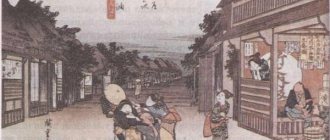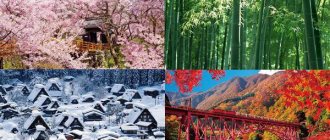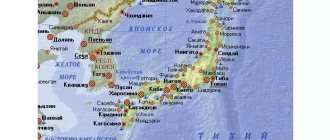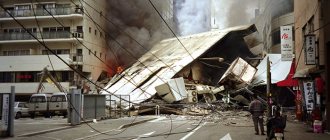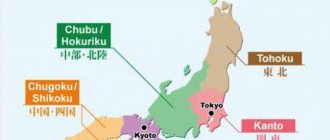Current state
Japan is poor in mineral resources - only reserves of coal, copper and lead-zinc ores are important. Recently, the processing of the resources of the World Ocean has also become relevant - the extraction of uranium from sea water, the extraction of manganese nodules.
In terms of the global economy, the Land of the Rising Sun accounts for approximately 12% of total production. Japan's leading industries are ferrous and non-ferrous metallurgy, mechanical engineering (especially automotive, robotics and electronics), chemical and food industries.
The concept of “International division of labor”
The sphere of exchange is evidence of the beginning of the internationalization of the economy.
With the initial accumulation of capital, local centers of inter-industry trade gradually transformed into a single world market. A competitive struggle began between countries, during which a system of international division of labor emerged. Definition 1
The international division of labor (ILD) is the production of goods and services in excess of the country’s domestic needs, intended for the world market.
The division of labor between countries is a way of organizing the world economy. Businesses produce and exchange certain goods and services.
MRI is influenced by the following factors:
Finished works on a similar topic
Course work Japan's participation in the international division of labor 420 ₽ Abstract Japan's participation in the international division of labor 240 ₽ Test paper Japan's participation in the international division of labor 220 ₽
Receive completed work or specialist advice on your educational project Find out the cost
- Provision of countries with natural resources;
- Geographical and climatic features of countries;
- Level of development of scientific and technological progress;
- Type of economic activity of countries;
- The nature of foreign economic relations;
- Level of development of regional economic integration;
- Education, culture, mentality of the country;
- The policies pursued by the government and the role of the state in the world.
The international division of labor presupposes:
- Goods and services are exchanged between countries;
- The process of capital movement between countries;
- Labor migration process;
- International economic integration.
There are three types in the international division of labor:
- General . This type involves exchange at the level of goods in the manufacturing and extractive industries, for example, the exchange of industrial goods;
- Private . This type of MRI involves the development of global trade in finished goods produced by a wide variety of industries. This is an exchange within the industry - a certain type of product is exported;
- Unit. We are talking about the specialization of countries only at a certain stage of production. Specialization at a certain stage of the technological process, for example, specialization in the production of certain parts.
Need advice on your academic work? Ask a question to the teacher and get an answer in 15 minutes! Ask a Question
In order to specialize in the production of certain goods, a country must have competitive advantages and the necessary conditions. Specialization can be territorial and production, which in turn is divided into subject and detail.
Note 1
The specialization of countries in the production of certain goods underlies the international division of labor. It already assumes that between countries there is a spatial gap between individual stages of production or production as a whole. In the national economies of countries, the scale of production is different and the possibilities for the division of labor within such a framework are limited, and this has a great impact on the division of labor between countries.
Industrial zoning
There are three largest regions within the state:
- Tokyo-Yokohama, which includes Keihin, Eastern Japan, Tokyo, Kanagawa prefectures, and the Kanto region.
- Nagoya, Tyuke belongs to him.
- Osaka-Kobsky (Han-shin).
In addition to the above, there are also smaller areas:
- Northern Kyushu (Kita-Kyushu).
- Kanto.
- Eastern Maritime Industrial District (Tokai).
- Tokyo-Chiba (this includes Keiyo, Eastern Japan, the Kanto region and Chiba Prefecture).
- Japan Inland Maritime Region (Seto-Nikai).
- Industrial area of the northern lands (Hokuriku).
- Kashima region (this includes Eastern Japan, Kashima, the Kanto region and Ibaraki Prefecture).
More than 50% of manufacturing industry revenues come from the Tokyo areas of Yokohama, Osaka, Kobe and Nagoya, as well as the city of Kitakyushu in the north of Kyushu Island.
The most active and stable element of the market in this country is small and medium-sized businesses. 99% of all Japanese companies belong to this area. However, this is not true for the textile industry. Japan's light industry (of which the above-mentioned industry is the leading element) is based on large, well-equipped enterprises.
Light and food industry
The positive characteristics of Japanese industry are ensured by the observance of production traditions in combination with the use of modern technologies. In short, some products for private trade are still made by hand, and large quantities for international markets are produced by enterprises.
As for light industry, the country spends a lot of money on importing raw materials, but finished products bring quite a lot of profit. The state is engaged in the manufacture of ceramic products, silk weaving, and the production of textiles from wool and cotton. Handmade goods are more valued. Huge areas of land are allocated for mulberry trees, where silkworms live, and cotton plantations.
Japan has large deposits of white and red clay, so the field of ceramics is well developed. Even industrial enterprises observe ancient traditions of processing raw materials and firing finished products. Thanks to this, Japanese tableware is distinguished by its high quality and extraordinary beauty. About 75% of products are exported, the rest is sold within the country.
The state has virtually no resources to provide food for the entire population. Because of this, the raw materials for the production of most products are imported. But Japan exports finished goods in huge quantities. In recent years, the demand for organic products has been growing in the country - the population is trying to adhere to a healthy diet.
Agro-industry
The country's agricultural land covers approximately 13% of its territory. Moreover, half of these lands are flooded fields used for growing rice. At its core, agriculture here is diversified, and it is based on agriculture, or more precisely, the cultivation of rice, industrial crops, grains and tea.
However, this is not all that Japan can boast of. Industry and agriculture in this country are actively developing and supported by the government, which pays a lot of attention to them and invests a lot of money in their development. Horticulture and vegetable growing, sericulture, animal husbandry, forestry and marine industries also play a significant role.
Rice occupies an important place in the agricultural sector. Vegetable growing is developed mainly in the suburbs; about a quarter of agricultural land is allocated for it. The rest of the area is occupied by industrial crops, forage grasses and mulberry trees.
About 25 million hectares are covered with forests, in most cases the owners are peasants. Small owners own plots of approximately 1 hectare. Among the large owners are members of the imperial family, monasteries and temples.
Energy of Japan
The basis of Japan's electric power industry is imported oil due to the country's lack of its own oil fields; its share reaches 80%, which makes the country's energy sector quite vulnerable. Japan ranks third in the world in electricity production, behind the United States and China. The basis of the electric power industry is thermal power plants, more than a thousand of them, and they are located mainly near large cities, of which there are many in Japan. The largest thermal power plants in Japan are located on the shores of the Pacific Ocean, near such megacities as Tokyo and Osaka. Also, nuclear power plants have been actively used in the Japanese electric power industry since the 80s of the 20th century. There are formally 42 operating reactors in the country, but only 4 of them actually produce electricity. In 2021, the Japanese government plans to launch 10 more nuclear power plants and increase the share of electricity produced by them. The issue of nuclear power plant safety plays an important role due to high seismic activity and frequent earthquakes, there are clear scenarios for actions in a critical situation, and constant checks of the safety and performance of equipment are carried out. The use of alternative energy sources in Japan is interesting. The country has many volcanoes and geysers, and attempts to use their energy were made already in the 70s. Attempts were also made to use solar energy, but in our time its share is less than one percent.
Livestock breeding
Livestock farming in the Land of the Rising Sun began to actively develop only after the Second World War. It has one peculiarity - it is based on imported feed (corn). Japan's own economy can provide no more than a third of all needs.
The center of livestock farming is the island. Hokkaido. Pig farming is developed in the northern regions. In general, the cattle population reaches 5 million individuals, and about half of them are dairy cows.
Fishing
The sea is one of the advantages that Japan can enjoy. Industry and agriculture receive multiple benefits from the country's island location: this is an additional route for the delivery of goods, support for the tourism sector, and a variety of food products.
However, despite the sea, the country has to import a certain amount of products (according to international law, the production of marine life is allowed only within the boundaries of territorial waters).
The main fishing objects are herring, flounder, cod, salmon, halibut, saury, etc. About a third of the catch comes from waters around the island of Hokkaido. Japan has not been spared the achievements of modern scientific thought: aquaculture is actively developing here (pearl mussels and fish are grown in lagoons and rice fields).
Transport
In 1924, the country's passenger car fleet numbered only about 17.9 thousand units. At the same time, there were an impressive number of rickshaws, cyclists and carts, which were propelled by oxen or horses.
20 years later, the demand for trucks has increased, mainly due to the growing needs of the army. In 1941, 46,706 cars were produced in the country, of which only 1,065 were passenger cars.
The Japanese automobile industry began to develop only after World War II, the impetus for which was the Korean War. More favorable conditions were provided by the Americans to those companies that took on military orders.
In the second half of the 50s, the demand for passenger cars also grew rapidly. By 1980, Japan had overtaken the United States to become the world's top exporter. In 2008, this country was recognized as the largest automaker in the world.
Industry
Since the second half of the twentieth century, the economic doctrine of Japanese industry was radically revised by the state. In addition to supporting the flagship of the economy, which was light industry, priority was given to heavy industry. A special niche has been allocated for high-tech developments.
Already by the 70s, the Land of the Rising Sun surprised the whole world with its rapid pace of development in such industries as electronics, instrument making, mechanical engineering, shipbuilding, medicine and science.
Japan is a country with a very highly developed industry.
Automotive industry
For more than 45 years, Japan's automotive industry has been one of the most developed in the world. The largest centers have been formed in such industrial areas as Tokyo, Yokohama, Nagoya, Osaka, and Kobe. Today, this industry rightfully defines the face of Japan.
Despite the automation of processes, the industry employs about six million people worldwide and approximately 700 thousand in the country itself. The automotive industry provides 1/10 of the state's GDP.
Active development of machine production began in the mid-1920s. The trigger for the automobile industry was the 1923 earthquake. A natural disaster destroyed railway and tram tracks.
The country needed trucks, buses and cars. Initially, American and General Motors built their factories near Tokyo. During World War II, production facilities were destroyed by bombing.
By the 50s, most of the enterprises were restored, and the first production of cars amounted to 30,000 units per year. The Korean War (between North and South) had a global impact on the Japanese automobile industry. The US Army ordered huge quantities of Toyota, Nissan, and Isuzu trucks and cars for its needs.
This video talks about the origin, development and formation of mechanical engineering in the Japanese automobile industry.
Along with the volume, the quality of the products also increased. After the end of hostilities, the “Japanese machine” could not be stopped. By 1980, Nihon Koku had overtaken America in the number of cars produced, taking first place in the world.
Number of cars produced in the USA and Japan (thousands, 1960–2005)
| A country | 1960 | 1970 | 1980 | 1985 | 1990 | 1995 | 2000 | 2005 |
| Japan | 760 | 5290 | 11 045 | 12 300 | 13 490 | 10 195 | 9480 | 11 500 |
| USA | 7870 | 7830 | 8010 | 11 430 | 9780 | 12 065 | 12 775 | 11 300 |
After the fuel crisis of 1973–1974. fuel-efficient Japanese cars captured the American market and continue to dominate it to this day. Flagship automakers Toyota, Nissan, Honda and Mazda have a network of production facilities in the USA and other parts of the world. The cars are of high quality and enjoy well-deserved respect among car owners in any country.
Electronics
The general development of heavy industry and science since the 1950s directly influenced the rapid development of electronics in Japan. Along with cars, the country began to export technically sophisticated goods. In the late 60s, Japanese radios and televisions became better than American ones.
By the mid-80s, Western markets were filled with VCRs and video cameras from the Land of the Rising Sun. Japan has made incredible technological breakthroughs in this industry. The development and production of more complex equipment—computers—began.
Companies from Japan have been occupying leading positions in the global electronic devices market for quite some time now.
Currently, about 1.6 million Japanese work in the electronics industry. More than half of them are working on new types of communications.
Available vacancies and salaries in Japan can be found on our website.
Aircraft industry
Serious development of the aircraft industry began in the 70s. Western countries did their best to prevent this after World War II, but in the end they decided to compromise. The main condition was put forward - the development of civil aircraft construction.
However, the Japanese were allowed to develop aircraft for the US military. The main problem for the domestic aircraft industry turned out to be dependence on the technologies of America and Western Europe. The industry needed industrial development of power plants and a large number of components that Japan was not able to produce.
The aircraft industry in Japan began to really develop only in the 1970s, thanks to agreements with Western countries.
To date, 146 enterprises engaged in the development and production of aviation equipment are registered in the country. Existing capacities are capable of satisfying 96% of domestic needs.
The largest aircraft manufacturers:
- Mitsubishi Heavy Industries.
- Kawasaki Heavy Industries.
- Fuji Heavy Industries.
- IHI is a leader in Japanese aircraft engine manufacturing.
*For the Boeing 787 Dreamliner (“Dream Plane”), Mitsubishi Heavy Industries produces the center section with wing consoles and some fuselage modules.
Shipbuilding
Japan's oldest industry, shipbuilding, remained leading for many centuries. Modern production facilities of the shipbuilding industry make it possible to build ships of all types and purposes.
The center of the industrial and industrial region of Kanto is spread between Kawasaki, Tokyo and Yokohama. There are a total of 75 shipbuilding companies registered in Japan. The leading enterprises are Universal Shipbuilding (USA), Mitsubishi, Kawasaki and Sasebo.
SHIPBUILDING is one of the leading branches of Japanese industry.
During this period, the demand for civilian ships is falling due to a decrease in ship traffic. Growing competition is also contributing to the decline in sales. But the industry is doing well, as orders from the military have increased significantly.
Many companies have equipped shipyards for the construction of aircraft, helicopter carriers and other ships for the Japanese and US Navy.
Shipbuilding
This is one of the leading industries, employing more than 400 thousand people, including those working directly at factories and in auxiliary enterprises.
The available capacities make it possible to build ships of all types and purposes, while as many as 8 docks are designed to produce supertankers with a displacement of 400 thousand tons. The activities of the industry are coordinated by ASKYA, which includes 75 national shipbuilding companies, which together produce about 80% of the total volume of ships produced in Japan.
The development of Japanese industry in this area began after World War II, when a planned shipbuilding program began to operate in 1947. In accordance with it, companies received very profitable preferential loans from the government, which grew every year as the budget increased.
By 1972, the 28th program provided (with state assistance) for the construction of ships with a total displacement of 3,304 thousand gross tons. The oil crisis greatly reduced the scale, but the foundation laid by this program in the post-war years served as a stable and successful growth for the industry.
By the end of 2011, the order book for the Japanese amounted to 61 million dW. (36 million brt.). Market share remained stable at 17% dwt, with the bulk of orders being for bulk carriers (specialized ships, a type of bulk carrier for carrying goods such as grain, cement, bulk coal) and a smaller portion for tankers.
At the moment, Japan is still number one in the field of shipbuilding in the world, despite serious competition from South Korean companies. Industry specialization and government support have created a foundation that keeps serious companies afloat even in the current situation.
Features of mechanical engineering
Japan is a country with advanced technologies in the field of mechanical engineering. Product exports are several times higher than imports. It is this industry that accounts for the majority of national income. There are several specializations in mechanical engineering:
- production of consumer electronics;
- automotive industry;
- robotics;
- shipbuilding.
The development of the industry began after the Second World War. In subsequent years, automobile production was limited by many legislative projects. Despite government bans, cars continued to be imported from abroad.
Imported cars were of high quality and seriously competed with Japanese products.
In the late 1950s, the government assigned businesses to fulfill military orders. After this, production volumes grew steadily. And already in the 1980s, Japan became a leader in car exports. The country occupied the first position for 15 years. Today, several concerns are considered world leaders:
- "Mazda".
- "Toyota".
- "Honda".
- "Nissan".
Companies have successfully dealt with economic crises and continue to produce improved products.
The mechanical engineering industry provided employment to a large part of the population. Taking into account the creation, service and maintenance of cars, about 6 million people work in this specialization.
In the 1990s, the development of science and high technology began, thanks to which the Japanese began to produce high-quality consumer electronics. Asian devices are distinguished by their reliability and manufacturability; they are imported to many countries around the world. Many enterprises produce optical instruments, medical equipment, computers, and electronic equipment. The state provides them with financial support, because such companies contribute to the development of the economy and science, and also increase GDP.
Metallurgy
The country has few resources, and therefore a strategy for the development of the metallurgical complex was developed, aimed at energy and resource conservation. Innovative solutions and technologies allowed enterprises to reduce electricity consumption by more than a third, and innovations were applied both at the level of individual companies and throughout the entire industry.
Metallurgy, like other branches of Japanese industry, received active development after the war. However, if other states sought to modernize and update their existing technologies, the government of this country took a different path. The main efforts (and money) were aimed at equipping enterprises with the most advanced technologies at that time.
The industry's rapid development continued for about two decades and peaked in 1973, when Japan alone accounted for 17.27% of the world's steel production. Moreover, from the point of view of quality, it claims to be a leader. This was stimulated, among other things, by the import of metallurgical raw materials. After all, more than 600 million tons of coke and 110 million tons of iron ore products are imported annually.
By the mid-90s, Chinese and Korean metallurgical enterprises competed with the Japanese, and the country began to lose its leadership position. In 2011, the situation worsened due to a natural disaster and the Fukushima-1 disaster, but according to rough estimates, the overall decrease in production rates did not exceed 2%.
Metallurgy of Japan
One of the most important industries in Japan is ferrous metallurgy, which experienced its boom in the 60-70s of the 20th century, against the backdrop of increasing construction volumes. However, after the crisis of the 80s, the iron and steel industry in Japan has been declining and is now going through hard times. Despite this, Japan remains one of the world's largest steel exporters, exporting more than 25 million tons annually.
Japan does not have its own mineral reserves, so the ferrous metallurgy industry is focused on imported raw materials: ore is imported from India, Australia and South Africa, and coking coal from Australia, the USA and Canada, which is why most metallurgical enterprises are located in coastal areas in close proximity to large cargo ports. Even despite the lack of its own raw materials, metallurgy in Japan has reached unprecedented heights, largely thanks to automation, as well as a large amount of investment in scientific and technological development. Now the main prospect for the development of the industry is to reduce energy costs and more efficient use of iron ores, which will reduce the country’s dependence on imported raw materials.
Chemical and petrochemical industry
The Japanese chemical industry produced products worth 40.14 trillion yen in 2012. The country is one of the three world leaders together with the USA and China, having about 5.5 thousand enterprises in the relevant field and providing jobs to 880 thousand people.
Within the country itself, the industry ranks second (its share is 14% of the total), second only to mechanical engineering. The government is developing it as one of the key areas, paying great attention to the development of environmentally friendly, energy- and resource-saving technologies.
Manufactured products are sold within Japan and exported: 75% to Asian countries, about 10.2% to the EU, 9.8% to North America, etc. The basis of exports is rubber, photographic products and aromatic hydrocarbons, organic and inorganic compounds, etc.
The Land of the Rising Sun also imports products (the volume imported in 2012 was about 6.1 trillion yen), mainly from the EU, Asia and the USA.
Japan's chemical industry is a leader in the production of materials for the electronics industry, in particular, about 70% of the world market for semiconductors and 65% of liquid crystal displays belongs to companies in this island country.
In modern conditions, much attention is paid to the development of the production of carbon fibers and composite materials for the nuclear and aviation industries.
Briefly about the territory and population
The Japanese state (officially Nihon Koku) is spread over an archipelago of 4,000 islands in the Asia-Pacific region. The string of pieces of sushi stretched for 3500 km. The main population is concentrated on the four largest islands.
The relatively small territory of Japan accommodates 127 million people. The country is among the top 10 countries in the world by population in 2021.
The largest and most populous islands of Japan
| Island name | Area, km² | Population, million people |
| Kyushu | 35 640 | 12 |
| Shikoku | 18 800 | 1,14 |
| Hokkaido | 83 400 | 5,34 |
| Honshu | 227 969 | 104 |
The water area of the state consists of many bays and bays. Thanks to the three seas and the Pacific Ocean washing the archipelago, the Land of the Rising Sun is rich in marine flora and fauna.
You will learn more about Japan from the video below.
However, UN experts predict a deterioration in the demographic situation in the state and a decrease in the number of local residents to 107 million people by 2050. This is a consequence of the low fertility rate. Now there are 146 newborns per 100 mothers, and for good demography there should be at least 200 babies.
The Japanese are a fairly healthy nation. The average life expectancy here is 80 years for men and 86 years for women. And this figure is gradually growing.
By 2095, the average life expectancy of a Japanese person will be 93.7 years. In terms of national composition, the country is 99% indigenous. The remaining 1% includes Koreans, Chinese and Europeans.
Almost 100 million people live in cities, 12 of which are cities with a population of one million.
*The most populous metropolis in Japan is the capital of the state, Tokyo. About 9 million people live here.
You can find out more about life in Japan here.
Electronics
Much attention is paid to the development of the information and telecommunications sector. The role of “the main locomotive of the industry” is 3D image transmission technologies, robotics, fiber-optic and wireless networks of the new generation, smart networks, and cloud computing.
In terms of infrastructure, Japan is catching up with China and the United States and is among the top three. In 2012, the total number of Internet users in the country reached 80% of the total population. Efforts and funds are directed toward the creation of supercomputers, the development of effective energy management systems and energy-saving technologies.
Energy
Japan was forced to meet approximately 80% of its energy needs through imports. Initially, this role was played by fuel, especially oil, from the Middle East. In order to reduce dependence on supplies, a number of measures have been taken in the Land of the Rising Sun, in particular with regard to the “peaceful atom”.
Japan began research programs in the field of nuclear energy in 1954. Several laws have been passed and organizations created to carry out the government's goals in this area. The first commercial nuclear reactor was imported from Great Britain, starting operation in 1966.
A few years later, the country's utility companies purchased the drawings from the Americans and, together with local companies, built facilities based on them. Japanese companies Toshiba Co., Ltd., Hitachi Co., Ltd. and others began to design and build light water reactors themselves.
In 1975, due to problems with existing stations, an improvement program was initiated. In accordance with it, the Japanese nuclear industry had to go through three stages by 1985: the first two involved changing existing designs in order to improve their operation and maintenance, while the third required increasing power to 1300-1400 MW and making fundamental changes to the reactors.
This policy resulted in Japan having 53 operating reactors in 2011, supplying more than 30% of the country's electricity needs.
Air and sea transport
Only in the 1970s did the aircraft industry begin to develop here. Japan has entered into agreements on the supply of equipment and testing of finished vehicles with other countries. But the state already has many more civilian planes and helicopters than military ones. The customers are private entrepreneurs and businessmen who need to move quickly or transport their products.
The Japanese government still continues to finance military aircraft production. The authorities are concerned that for many years now they have not been able to overtake the United States in this area. The fact is that the Asian country depends on the United States, as it constantly has to coordinate the production of parts and engines. Japan still lacks its own scientific and technological resources, although the government is investing a lot in creating its own enterprises for the manufacture of such products.
The state is washed by the waters of the Pacific Ocean and seas, so shipbuilding is also developed in it. Well-known companies are engaged in it - Sasebo and Mitsubishi. Their branches and factories are located on the coasts. But recently they have begun to produce fewer ships, as demand for this type of transport has been falling since the 1980s. The remaining factories produce ships ordered by the Navy and private entrepreneurs, and there are still enough of them to provide jobs for residents of coastal cities.
After Fukushima
In 2011, Japan's energy industry took a major hit. As a result of the strongest earthquake in the history of the country and the subsequent tsunami, an accident occurred at the Fukushima-1 nuclear power plant. After a subsequent major leak of radioactive elements, 3% of the country's territory was contaminated, and the population of the area around the station (approximately 80 thousand people) became displaced.
This event forced many countries to think about how acceptable and safe the operation of the atom is.
There was a wave of protest inside Japan demanding that they abandon nuclear energy. By 2012, most of the country's stations were switched off. The characteristics of Japanese industry in recent years can be summed up in one sentence: “This country is striving to become green.”
Now it actually no longer uses nuclear power; the main alternative is natural gas. Much attention is also paid to renewable energy: solar, water and wind.
Chemistry and robotics
Japan is a leader in the international robotics market. With the help of this industry, the needs of industries, as well as the aging population, are met. The government finances enterprises that produce industrial and industrial equipment, as well as robots that become real assistants to housewives and people with disabilities.
Managed healthcare associates have become popular in recent years. Japan also produces humanoid robots. They not only repeat the movements and words of people, but also reproduce facial expressions and solve simple mathematical and logical problems. Automotive companies produce such equipment.
The chemical industry is also considered important for the economy. In the 1960s, active oil production began, fuel waste appeared, and the need arose for its processing. In terms of development of the chemical industry, Japan ranks first in Asia and second in the world. Leading companies:
- "Asahi Voice"
- "Sekisui Kamikle."
- Fuji Photo Film.
- "Asahi Chemical".
- Mitsubishi Chemical.
The most developed industries are the production of plastics, synthetic rubber and chemical fibers, as well as the processing of oil waste.
Biochemistry is considered to be developing: the development and production of fertilizers and medications. The country exports decorative and medicinal cosmetics, medicines, industrial and household chemicals. Since there are many factories in Japan, they cause harm to the environment. To prevent this, entrepreneurs use modern clean technologies.
